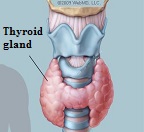

Iodine: content limited to what we believe we need to know about iodine in our daily life, based on our experience and readings.
All words below in italic are quoted from Health Direct (Australian Government website), unless otherwise stated.
Iodine helps the thyroid gland, in your neck, make the hormone thyroxine. Thyroxine controls many of the ways certain cells in your body work. Thyroxine is important for the growth of your bones and nerves, and how proteins, fats and carbohydrates are used in your body.
>> access the article
Iodine helps the thyroid gland, in your neck, make the hormone thyroxine. Thyroxine controls many of the ways certain cells in your body work. Thyroxine is important for the growth of your bones and nerves, and how proteins, fats and carbohydrates are used in your body.
>> access the article
Seafoods such as oysters, snapper and seaweed have lots of iodine. Tinned salmon, bread, eggs, milk and milk products such as yoghurt also contain iodine.
Iodine is also added to many types of salt. You can check on the label. Iodised salt is now used in bread making. The packaging will tell you how much iodine the bread contains.
>> access the article
Iodine is also added to many types of salt. You can check on the label. Iodised salt is now used in bread making. The packaging will tell you how much iodine the bread contains.
>> access the article
How much iodine you need depends on your age and stage of life.
(Source: Food Standards Australia and New Zealand)
| Stage of life | Recommended daily intake for iodine (micrograms per day) |
| Children aged 1 to 8 | 90 |
| Children aged 9 to 13 | 120 |
| Adolescents aged 14 to 18 | 150 |
| Pregnant women | 220 |
| Breastfeeding women | 150 |
| Other adult women | 150 |
| Adult Men | 150 |
- Too little or too much iodine can cause problems:
- Too little iodine may cause extreme tiredness, feeling cold, problems concentrating and hair loss. And without enough iodine, the thyroid gland may enlarge to form a goitre. It shows up as a lump in the neck.
- Too much iodine (usually from supplements) can be dangerous for people with thyroid disorders.
Based on a diet where nearly no processed food is eaten, our iodine comes from the following sources:
iodised rock salt and iodised table salt found in supermarkets and tinned salmon, eggs, yoghurt, and fresh seafood such as sardines, salmon, squid usually grilled or panned.
So find out what works for you ensuring you take care of your thyroid as it acts as your control box.
- How much iodine is too much for me?
- Given the above symptoms for too little iodine, I now rely on my body to let me know.
- In the past, I have had such symptoms and saw my GP. The thyroid was working in low gear!
- It turned out that I had NO thyroid issue but because I had digestive issues and basically did not eat, I was lacking protein.
On the blood test, my protein levels were too low and my body thought I was in famine and did not think the control box (the thyroid) needed to work as hard. Hence the low gear. As soon as I started eating the appropriate amount of protein and got my energy back and resolved some of the digestive issues, the thyroid returned to its normal self. So in doubt, and with symptoms, see your GP to get your thyroid function tested.
- How much iodine is ** not ** too much for me?
- As far as I know I do not have thyroid disorders. My father did have thyroid cancer like many of the French people who were exposed to the explosion of the nuclear power plant in Chernobyl in 1986 and beyond.
>> read more on Chernobyl
- So again I will need to rely on noticing changes to my body and on targeted blood tests to verify issues if any.
So find out what works for you ensuring you take care of your thyroid as it acts as your control box.